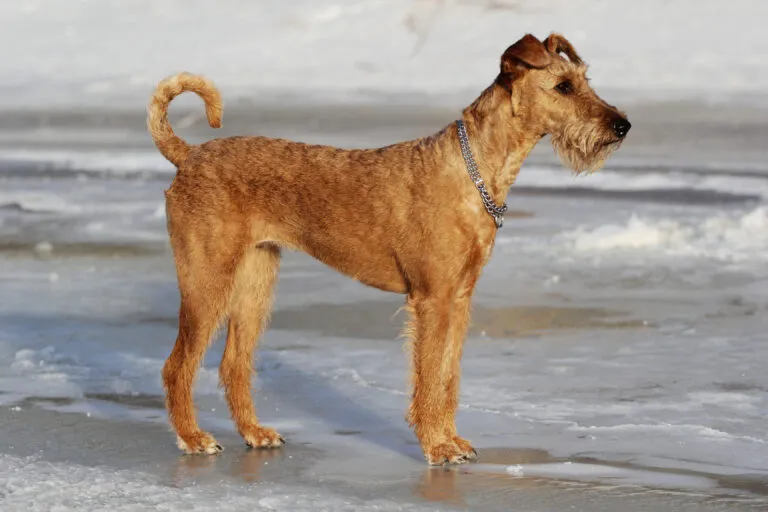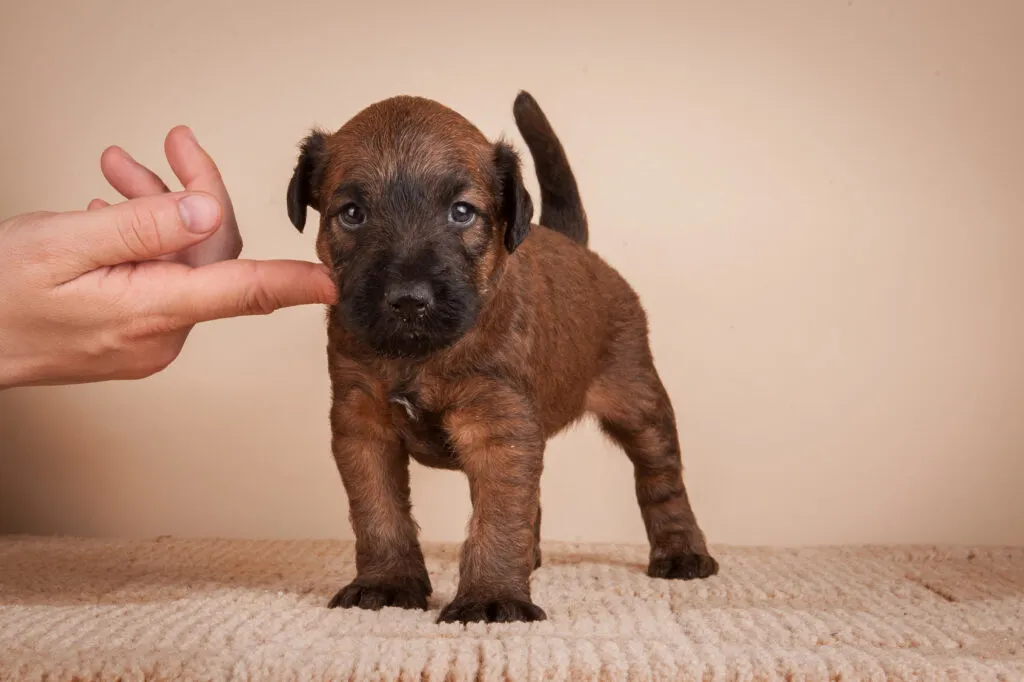Medium Size Poodle
A rough-and-tumble dog and a cuddly companion, a daredevil and a friend to children: An Irish Terrier combines many contradictions. This lovable character is an excellent companion for experienced dog owners who enjoy spending ample time with their dogs in the great outdoors.

© zelenka68 / stock.adobe.com
The Irish Terrier’s harsh topcoat and soft undercoat protect it from the elements while giving it its signature red or wheat-colored look
The Irish Terrier is a medium-sized, compact, and elegant dog, standing around 45cm at the shoulder, with males weighing up to 17kg – females are somewhat lighter. Overall, size and weight can vary significantly within the breed.
The similarly appearing but larger Airedale Terrier is related to the Irish Terrier. The Irish Terrier’s fur consists of a soft undercoat and a harsh top coat. This fur protects it optimally from the weather and must be regularly trimmed to give the Irish Terrier its distinctive look. The coat can be red or reddish wheat-coloured – some even describe the colour as gold.
Although the Irish Terrier is affectionately called a “red devil” by enthusiasts and the breed’s colour range is defined by this, its history as a hunting dog is quite colourful: Among its ancestors are black-and-tan English Terriers and wheaten-coloured Terriers from Ireland. Its current appearance could already be found in South Ireland by the 19th century, where it has been deliberately bred since 1870.
The Irish Terrier Club was founded in 1879. Originally, this Terrier was used primarily for hunting rats and in hunting in general, sometimes unfortunately in dog fights as well. Even today, some hunters venture into the forest with an Irish Terrier.
One of the most beautiful declarations of love for the breed is by author Jack London in his book “Jerry of the Islands”, where he writes of an Irish Terrier named Jerry, “he was pure gold, inside and out.”
The Irish Terrier carries the nickname “red devil” or “daredevil” for a reason: It is a very spirited dog with a tendency to be headstrong. Additionally, it is territorial and often incompatible with other dogs – a trait linked to its past use in dog fights. With these attributes, an Irish Terrier is usually well-suited to guarding. Only fans of such a rugged character should consider living with this breed.
Along with its tough nature, it also has a strong hunting passion, which influences walks and outings. Anyone who has an Irish Terrier as a friend has found a proverbial friend for life: It is very loyal to its owner and loves shared activities as well as cosy togetherness – provided the clever bundle of energy is regularly physically and mentally challenged. While it may be wary of strangers, it is loving and joyful in activities with its family.
 © anya_titanya / stock.adobe.com
© anya_titanya / stock.adobe.com
Due to its determination, hunting drive, and the inconvenient trait of repeatedly challenging the pack leader’s authority, the Irish Terrier is best suited for experienced dog owners. It has an inherent sharpness. The existing hunting drive should not be underestimated, and the Terrier and former rat hunter may interpret potential “prey” quite generously. Therefore, a consistent training that leaves no room for leniency is essential with this challenging character.
If the Irish Terrier accepts you as the pack leader, you will have a pleasant companion by your side. However, getting to this point requires plenty of experience. Due to its hunting drive, you can rarely let an Irish Terrier off the lead. Take this dog to puppy school, as this will promote the social skills of the solitary dog. Also ideal is hunting training. Before bringing your dog home, look for suitable dog schools that ideally have experience with Terriers.
The breed is considered robust, with a life expectancy of 13 to 14 years. The fact that the Irish Terrier never became a trendy dog or was bred for extremes has benefited its health – it remains a hearty natural dog. Several decades ago, cases of hyperkeratosis were common in the breed. This condition causes painful skin thickening. But targeted selection has now largely excluded the genetic predisposition to this problem.
Important: Buy only from a reputable breeder!
Some Irish Terriers are prone to hypothyroidism, skin problems, or paw deformities – a reputable breeder also prevents this. While an Irish Terrier can develop hip dysplasia, the risk is relatively low compared to other dogs due to its lighter body weight.
Nonetheless, it is sensible to ensure a healthy diet in the right amount and appropriate exercise. Dental hygiene can positively impact your dog’s health into old age. Some owners therefore introduce their puppies to dental hygiene with a toothbrush and special dog toothpaste – preventing tartar and consequent diseases effectively.
From a young age, your Irish Terrier should get used to regular care. Ideally, the puppy should already have been trimmed by the breeder before coming to you.
Nonetheless, familiarisation with the trimming table should occur during puppyhood. Actual trimming takes place at least twice a year. This involves removing dead hair by plucking in the growth direction – ideally done by a professional groomer since achieving a harmonious overall look requires not only skill but also experience and the right trimming tools. Watch a few times before attempting it yourself, possibly under guidance.
The significant advantage of trimming is that fewer hairs end up in your home, as most are removed with the trimming knife. Do not use scissors on your dog’s fur, as this would affect the texture and colour, taking away the Irish Terrier’s characteristic appearance. Regularly check your dog’s claws and trim when necessary with a claw trimmer. Additionally, inspect its ears every few days and clean them with a special ear cleaner if needed.
An Irish Terrier needs food that keeps it active and healthy with high-quality proteins. Whether you opt for wet or dry food, ensure it has meat as the primary component: Meat should be listed first in the ingredient declaration. The energy needs of an Irish Terrier strongly depend on how much it exercises daily – thus, regularly check your adult dog’s weight and adjust calorie intake as required.
Treats can be both healthy and delicious: For example, choose dental hygiene snacks with additional benefits for health, offer items like dried beef ears to satisfy your dog’s chewing needs, or provide air-dried snacks made from pure meat.
If you want to change your Irish Terrier’s diet, do so only once it has settled in its new home. Always proceed slowly, initially mixing a small amount of new food with the known one to avoid sensitivity reactions like diarrhoea or vomiting. Gradually increase the portion of new food each day. Always provide your dog with fresh water as needed.
This spirited bundle of energy loves being active with you. However, leaving it in the garden while you relax isn’t enough – it craves shared activities! It needs not only physical but also mental engagement, being intelligent and curious. Therefore, numerous activities are available – find out what brings you both delight!
An adult Irish Terrier makes a great jogging companion, though it often needs to stay on the lead. Irish Terriers enjoy working – besides being trained as hunting dogs, some successfully undergo training as rescue dogs. Agility, obedience, tracking, protection work, and even dog dancing – in all these activities, an Irish Terrier can participate with joy.
 © zelenka68 / stock.adobe.com
© zelenka68 / stock.adobe.com
An Irish Terrier should only go to experienced dog owners who love its determined character and can guide it appropriately. This requires ample time for training and joint activities in the great outdoors. The Irish Terrier loves exploring nature, making it less suitable as a city dog. It feels most at home in a house or apartment with an attached garden where it can roam freely and guard. However, ensure the garden is securely fenced to prevent the little hunter from going on an independent hunt!
A well-trained Irish Terrier fits well in a family and usually gets along wonderfully with kids – intense friendships can form especially if the children are older. Introducing it to cats can be challenging and should only be attempted if the puppy has been socialised with cats. Otherwise, there’s a risk the Terrier will view cats as prey – especially with neighbours’ cats. Never leave your Irish Terrier alone with small animals – its instinct to hunt rats is still strong.
Even if you’re already set on the Irish Terrier, a new canine family member’s arrival should be well-thought-out. A puppy will be with you for up to 14 years and will significantly shape your everyday life. All family members should agree on the new addition – particularly because this breed has a distinct character with typical Terrier traits.
Do you have enough time daily for nature activities and extensive walks? When budgeting, consider not only acquisition and basic equipment costs but also ongoing expenses. These include quality food and vet visits – which can quickly turn costly if your dog gets sick. You may also need funds for a dog school and groomer, and definitely for dog tax and liability insurance. It’s wise to roughly estimate these costs beforehand.
Think carefully about how you will arrange holiday care for this special dog – or whether you’ll take it along on your travels. The Irish Terrier makes a great companion for a hiking holiday in temperate climates.
This spirited dog isn’t a trendy pet, but there are enthusiasts and breeders across Europe. If you’re thinking of getting an Irish Terrier, choose a puppy from a reputable breeder or give a new home to an Irish Terrier that has lost its home. Avoid so-called “breeders” not affiliated with any organisation – they often seek quick profit, neglecting the socialisation and health of this challenging breed.
Take the opportunity to visit the breeder and meet the parent dogs, asking the breeder all questions about your future companion and its care. Your puppy will join your home at eight weeks old at the earliest, already vaccinated, chipped, and carrying a pet passport. Don’t forget the booster vaccination appointments.
If you’re offering an older Irish Terrier a new home, check with local animal rescue shelters or Terrier clubs that often have older dogs looking for new homes. These dogs may come with solid basic training – or behavioural challenges that require expertise and patience. Gather detailed information about the dog’s traits from the rescue organisation and match them with your lifestyle and experience. Arrange a preliminary meeting to get to know each other.
We wish you much joy with your characterful Irish Terrier!
Fans of the Bearded Collie agree that those who aren't familiar with this dog breed simply have to get acquainted with it. And those who have experienced how a Bearded Collie bolts across meadows with its flowing fur, how it rolls around full of energy and joy and how it attentively and observantly takes into account its owners wishes become simply addicted to this original dog breed and its unique charm.
The Goldendoodle isn't a breed, but a pairing between Golden Retrievers and Medium or Standard Poodles. Marketed as a low-maintenance dog for allergy sufferers, this hybrid is enjoying increasing popularity amongst dog lovers, similar to the Labradoodle.